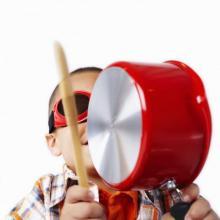
Pretend play is a form of symbolic play where children use objects, actions or ideas to represent other objects, actions, or ideas using their imaginations to assign roles to inanimate objects or people.
Toddlers begin to develop their imaginations, with sticks becoming boats and brooms becoming horses. Their play is mostly solitary, assigning roles to inanimate objects like their dolls and teddy bears.1
Preschoolers, from ages 3 to 5 years, are more capable of imagining roles behind their pretend play. Their play becomes more social, and they enjoy make-believe play. They assign roles to themselves and others involving several sequenced steps often with a predetermined plan, like pretending to be at the doctor’s office or having a tea party.2
Progression Of Pretend Play
Research inspired by Jean Piaget produced the following descriptive progression of pretend play:
- Single pretend transformation toward self (with toys that resemble real objects): The child hugs a doll or toy animal; the child pretends to eat toy food.
- Object is pretend agent (with toys that resemble real objects, object is treated as if it acts): The child has a doll act as if it is eating toy food.
- Single pretend transformation (with toys that have no resemblance to real objects): The child creates a bed out of building blocks; the child forms a pancake from molding clay.
- Pretend role (with toys associated with a role that resembles real objects): The child pretends to be a cook with toy food; the child pretends to be a policeman with a toy badge and a toy car.
- Multiple pretend role transformations (with toys that resemble real-world objects): The child takes roles, such as doctor, patient, and nurse while playing with dolls or toy animals.
- Pretend role (without the support of toys that resemble real objects): With blocks or molding clay, the child constructs the objects needed for the pretend setting, such as a farm with blocks and farm animals from the molding clay.
- Multiple pretend roles (with toys that resemble real-world objects): A group of children use doctor’s office toys and play roles as doctor, patient, and nurse.
- Multiple pretend roles (without toys that resemble real objects): Children use blocks or molding clay to create the pretend setting and designate roles to enact.3
As children advance linguistically, cognitively, and socially, their play begins to include fantasy, drama, and imitation. Dramatic play is where a child pretends to take on the role of someone else, imitating actions and speech from an earlier observed situation. When another person becomes involved in the play, it is called sociodramatic play. Sociodramatic play is the most advanced form of symbolic play and requires the use of imagination to carry out their roles.4 Children learn skills in negotiation, listening, sharing, taking turns, and respecting others’ feelings, thoughts, ideas, and physical space through sociodramatic play.5
How Parents & Teachers Can Enhance Pretend Play For Children
Parents, daycare centers, and schools can enhance the child’s ability to play make-believe by providing loose parts that have more than one purpose, such as building blocks, boxes, and nonrealistic materials that can be imagined symbolically as other objects. Costumes, props, and themed settings, such as play grocery stores or dollhouses, all allow for pretend play.6
Connection Between Social Skills And Outdoor Playgrounds
Outdoor play on playgrounds enhances motor development and social skills that allow for fuller expression and freedom through active movement and loud talk. The outdoor environment offers greater availability of low-structured, non-realistic, natural materials, and spaciousness that encourages pretend play. Boys engage in more dramatic play and girls are more assertive when playing outdoors.7
Playground Designs Linked To Increased Imaginations
New innovative playgrounds are being designed that greatly encourage make-believe play. Old West towns, forts, castles, pirate ships, rescue fire trucks, trains, and space ships are some of the themes built into today’s playgrounds.8 Slides, fire poles, overhead ladders, climbers, bridges, and spring rockers all promote pretend play as well as decks, roofs, tunnels, talk tubes, and bubble panels. Platforms with window and door cutouts create places for children to engage in pretend play.9
- 1. Frost, Joe L., Pei-San Brown, John A. Sutterby, Candra D. Thornton, The Developmental Benefits of Playgrounds Olney, MD: Association for Childhood Education International, 2004. p. 23.
- 2. Ibid., p. 24.
- 3. Frost, Joe L., Sue Wortham, and Stuart Reifel. Play and Child Development. Upper Saddle Valley, NJ: Prentice-Hall, 2001. p.48.
- 4. Ibid. p. 186.
- 5. Op. cit., Frost, Brown, Sutterby, Thornton. pp. 24-25.
- 6. Trawick-Smith, Jeffrey. “Symbolic Thought: Play, Language, and Literacy in the Preschool Years” Early Childhood Development: A Multicultural Perspective, 3rd ed., Prentice Hall. < http://wps.prenhall.com/chet_trawick-smith_early_3/5/1495/382746.cw/index.html > 20 Aug 2010.
- 7. Op. cit., Frost, Wortham, Reifel. pp. 430-431.
- 8. “Themes.” Landscape Structures. < http://www.playlsi.com/Explore-Products/Park-Themes/Pages/Park-Themes.aspx > 20 Aug 2010.
- 9. Brown, Pei-San, John Sutterby, and Candra Thornton. “Dramatic Play in Outdoor Play Environments.” PTO Today. < http://www.ptotoday.com/play3.html > 23 Aug. 2010.

